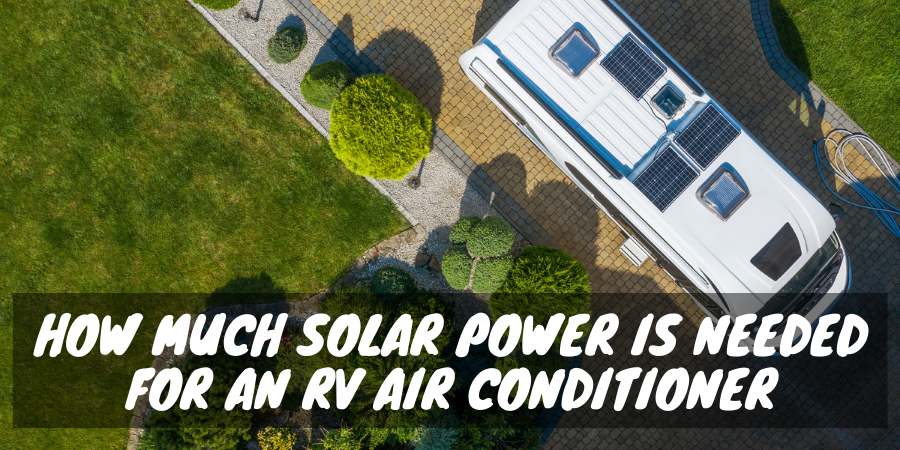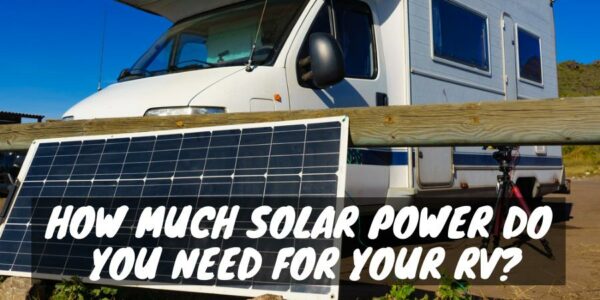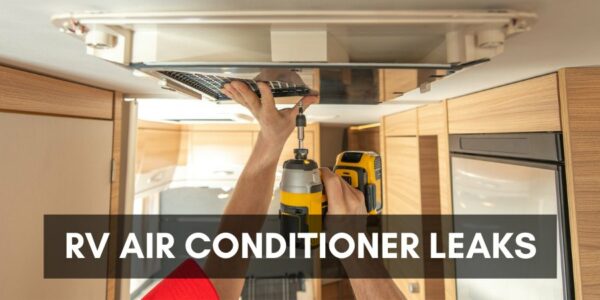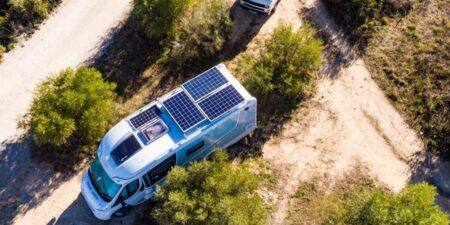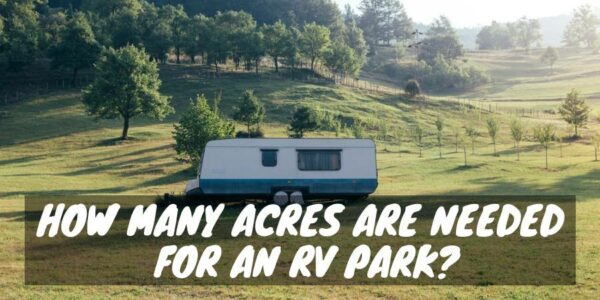Off-grid camping is very popular, but most RVers want all the comforts of home when boondocking, including running the air conditioner in hot weather.
So, how can you achieve enough amperage to operate such a sizable power-drawing appliance when your RV isn’t plugged into shore power?
Solar power is the answer, but you need to have a robust enough system to keep your RV cool while still running other appliances. But let me warn you, setting up such a system will not come cheap.
To help you see if you can achieve this goal, I detail all the aspects of RV solar power down below, so you know exactly what it takes to maintain a comfortable off-grid living situation, so stick around to learn more!
How RV Solar Power Works
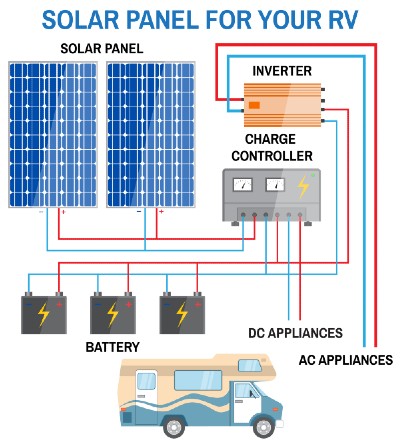
Setting up your RV for solar power or increasing the capacity of a current system requires four components:
- Solar panels and wiring
- Battery bank
- Charge controller
- Inverter
Each component plays a role in collecting, storing, and delivering power safely to run RV appliances.
SOLAR PANELS
Solar panels come in various sizes and types, and the maximum power they can deliver to the battery for storage until use.
The job of the panel is to capture the sun’s rays and transform them into energy. The concept is straightforward, and solar power is a very eco-friendly way to create “free” energy for your RV boondocking trips.
But, RVs have a space limit to permanently attach panels to the camper’s roof, which can severely constrain power generation. Often, this level of power is below what it takes to run most recreational vehicle air conditioners.
For RVers who want to self-sustain off-grid without using a generator for power, the only solution is to use free-standing solar panels in conjunction with roof-mounted panels while at a campsite.
All solar panels will need wiring harnesses that lead from the panel to the battery bank. For an extensive system with many panels, the wiring may require the help of a professional to ensure it’s correct, which is another expense to consider.
The biggest problem with purchasing solar panels is that the wattage or amperage output is rarely, if ever, at max levels. Clouds, nighttime, rain, angle of the sun all lower the level of power the panel can collect from the sun.
This RV solar power system efficiency fact means you’ll need additional panels to offset the loss, which you may not have the space or budget to handle.
Which Solar Panels Are Better, Rigid or Flexible?
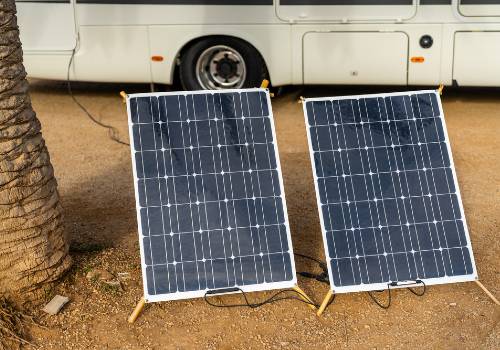
The solar panel you select will depend on your RV roof material. Both rigid and flexible solar panels need secure attachments so they don’t shift, rattle, or break loose during miles of road travel.
Rigid panels are popular for two reasons. One, they are less expensive, and secondly, you can opt for special mounting brackets that allow you to tilt the panels to capture more direct sun.
The downside of rigid panels is the mounting brackets you screw into your roof, which opens up the possibility of leaks. You also can’t walk on the panels, so trying to handle RV roof maintenance chores will probably be next to impossible.
Flexible panels glue onto your roof and are permanent. People choose flexible panels because they are very low-profile and can fit the curves of many RV rooflines.
You can also walk on the most flexible solar panels and not cause damage so that you can access your roof without worry.
The downfall of flexible solar panels is that your roof membrane must support the adhesives necessary for secure installation.
BATTERY BANK
You can collect all of the sun’s energy you want, but without batteries to store it, you’ll be wasting your time and money.
Batteries are another expensive and heavy addition to an RV solar setup. You’ll need to have ample energy storage to maintain running the RV air conditioner, even when the panels are not actively gathering power.
The average RV air conditioner will require around a 700 to 800-amp-hour battery bank to run the unit for a few hours after dark when the solar panels are not actively replenishing the charge.
Batteries for RV solar systems should be lithium-ion, which can’t be overcharged and provides better performance than lead-acid batteries. Lithium-ion batteries cost more, but they are safer, more efficient, and lighter, which offsets the investment.
CHARGE CONTROLLER
A critical element of an RV solar power setup is the charge controller. A charge controller regulates the speed and level of power running to the battery bank to prevent overcharging.
Overcharging a lead-acid battery will shorten its lifespan and be very dangerous, leading to bulging, smoke, or even a fire.
Lithium-ion RV batteries are much safer, but they can go bad when power drops too low for an extended time frame.
INVERTER
The last element you’ll require to run your RV air conditioner with solar power is an inverter.
An inverter takes 12-volt power from the battery pack and converts it to 120-volt energy to run the AC or other appliances.
The size inverter you’ll need depends on the maximum power surge the AC requires to start up. Once the unit starts and the compressor kicks in, the power draw drops to a lower, more consistent level.
For example, the initial starting wattage of your AC is 3,000 watts, so your inverter must be able to provide this level of power, or it won’t start the unit. The larger the wattage of your inverter, the more expensive it becomes.
Solar Power Requirements for an RV Air Conditioner
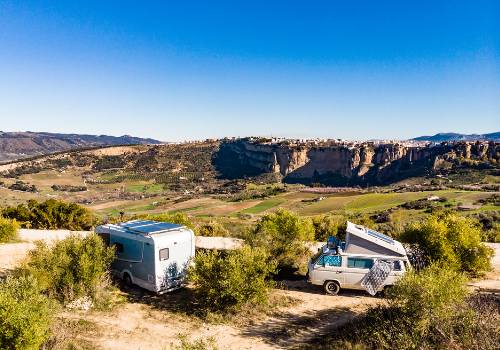
Let’s now get into more exact requirements to set up a solar power system in your RV to handle running an air conditioner.
How many solar panels are necessary to operate a recreational vehicle air conditioner? You’ll need more than you think.
You’ll need to have enough solar panels for about 2,500 watts of power just to run a standard RV air conditioner and not any other appliance in your camper.
An average solar panel measures about 39 inches in width and 65 inches in length. You’ll need eight to nine 300-watt solar panels to generate the wattage you require.
If you choose 200-watt solar panels, you’ll need 13 units to sustain the power you require.
Does your RV have that much available roof space?
Do you have the approximate $3,000-$4,000 to purchase the panels and wiring if you have space? Do you have the skills to install the panels yourself, or will you need to pay extra for professional help?
You must ask yourself these essential questions before moving forward with your RV solar system plans if you want to support running an air conditioner while boondocking.
Battery Bank Requirements for an RV Air Conditioner
Let’s assume you’ll need a battery bank that can produce 800 amp-hours of power to run your RV air conditioner.
Many off-grid campers have a battery bank that holds 300-400 amp-hours of power for general use of lights and small appliances. If they want to upgrade to run the air conditioner, they’ll have to double their house battery bank size.
You will need eight 12-volt 100 Ah lithium-ion batteries for the best performance. Each battery costs about $1,000 for a total battery expense of $8,000.
Of course, there can be a wide range of battery types and voltages you could theoretically install to store power in your RV. For example, some RV techs find that using Tesla Model S batteries at 24-volt saves weight and increases efficiency to allow the air conditioner to run.
Pinpointing the exact battery arrangement depends heavily on RV type and whether or not you have space available to install such a large battery bank to sustain air conditioner operation.
Inverter and Charge Controller Requirements for an RV Air Conditioner
The inverter you’ll need to power your air conditioner and other appliances will need to be a minimum of 3,000 watts but can be as much as 5,000 watts.
A quality 3,000 to 5,000-watt RV inverter starts at around $2,000.
The charge controller that can handle such an extensive solar power system will cost on average $600.
You need to understand the difference in power output readings from your inverter or battery charge controller. Amperage draws are different between AC and DC power.
For example, if your air conditioner label says it draws 15 amps when running off 120-volt AC power, the amperage when running it off 12-volt DC power will be ten-fold or 150 amps.
You’ll need a good grasp of the differentials of power between 12-volt and 120-volt electrical systems to install, operate, and troubleshoot any RV solar power system.
Total Estimated Solar Power Cost to Run an RV Air Conditioner
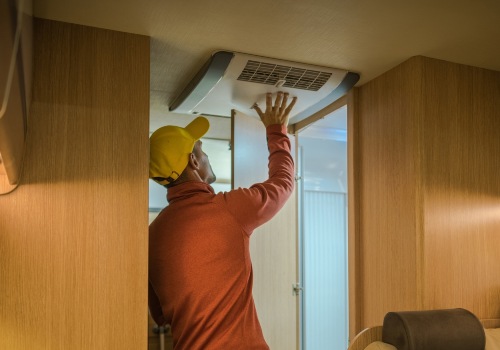
To purchase all the components to use solar power to run an RV air conditioner, you’ll need:
- Solar panels – $3,500
- Batteries – $8,000
- Inverter – $2,000
- Charge controller – $600
- Accessories – $400
Want to Connect With a Community of Over 1,078 RV Enthusiasts?
The total estimated cost of $14,500 is about what you should expect to install quality solar power for an RV system from scratch that can run a camper air conditioner.
You can choose to purchase less expensive or used components and lower this figure considerably, but most RVers find the investment not worth the hassle and upkeep.
The option to stay cool in the RV using a low-energy-draw $20 fan seems much more appealing. You can also decide to run a generator that can easily operate the RV air conditioner and just put up with the noise while dry camping.
Again, I must stress how much space it takes in your RV for both the solar panels and battery bank to sustain AC power. Most RVs don’t have room.
Other Considerations to Run an RV Air Conditioner Off Solar Power
Installing the Electrical Components Correctly
Getting your RV ready to run your air conditioner from the battery bank along with standard 120-volt shore power will require some electrical work.
The air conditioner must have wiring that runs to the inverter. The panels must all wire down to the battery charge controller. All the components must be in the proper order for correct power flow.
This wiring task may be challenging and require an expert electrician skilled in RV solar to get the job done right.
RV Solar Power System Maintenance
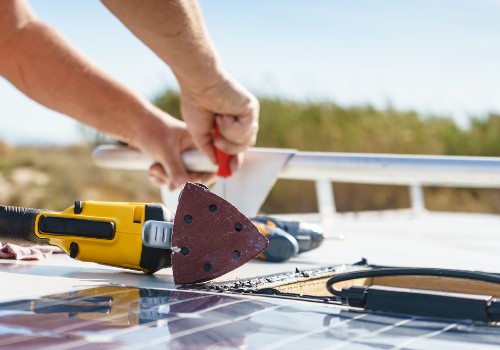
Don’t forget that once you have everything up and running on an RV solar power system, you’ll still need to consider what it’ll take to maintain all of the components.
A standard RV requires continual upkeep, which many owners already find time-consuming, so adding more elements to the mix may be too much.
Do you need to wipe down all the panels and inspect the mounting and wiring attachments every few months? How long will the batteries work before they need replacement?
Is It Worth It to Install an RV Solar Power System to Run the Air Conditioner?
Once a solar setup is complete and running as it should, having no-cost, silent energy generation is a blessing for any RVer on or off the grid.
But, to achieve free energy, you’re going to need to expend quite a bit of time and money to get there. If you don’t use your camper often or plan to keep your RV long-term, the dollars vs. benefits will not pay off.
If you have the money and a large enough RV to install such an enormous solar array, you probably will have no issues enjoying hours of cool air from your AC while boondocking in a warm climate, even if you camp once a year.
How to Calculate RV Solar Power Needs
Every RV will have different solar power needs, but the easiest way to start figuring is to understand the size of your RV’s electrical system in kilowatts (kW).
To figure the watts, you multiply the kilowatt figure by 1,000.
A 30 amp RV plug can deliver a maximum of 3,600 watts or 3.6 kW.
A 50 amp RV plug can deliver a maximum of 12,000 watts or 12 kW.
If you want to install 300-watt solar panels, you need to divide this number by your wattage total (see below for example) to know how many panels to buy.
For example, you want a total of 3,600 watts (or 3.6 kW) of power for your 30-amp travel trailer or motorhome.
3,600 divided by 300 equals 12 panels. If you had intentions of using 100-watt solar panels, you would need 36 panels, which isn’t going to fit on any RV, sorry.
Do use a handy RV solar power calculator for a complete look at what your requirements may be.
Final Thoughts
Solar for RVs is a beautiful asset that makes going off-grid camping very enjoyable. Saving on campground electric fees is another bonus of installing RV solar.
Going large with your RV solar system to include running your air conditioner is possible, but it will require a large RV to hold the panels and hefty cash investment to install it and keep it running.
No matter what solar option you choose, the best part is you’re out enjoying camping adventures in your RV, and that is worth every cent!
Running an Air Conditioner off of Solar Power How I Do It! (Video)
"Man cannot discover new oceans unless he has the courage to lose sight of the shore."
-- Andre Gide

